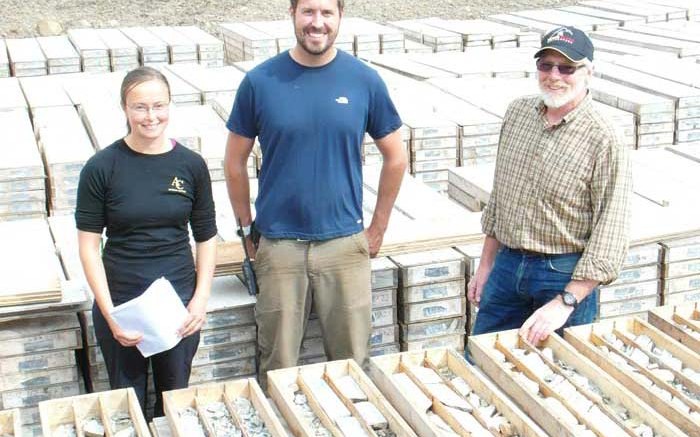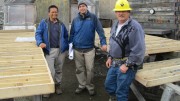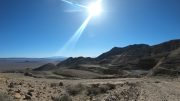KENO CITY, YUKON — ATAC Resources (TSXV: ATC) has discovered nine gold zones in four years, many of which offer high grades. That alone is impressive, but the kind of gold ATAC is uncovering in the eastern Yukon is equally attention-getting: the Rackla project is home to micron-scale gold related to disseminated arsenian pyrite within decarbonatized sedimentary rocks.
That kind of geological jargon sets gold seekers’ hearts racing because it describes Carlin-style mineralization. Nevada’s Carlin trend is one of the world’s richest gold districts, with a known gold endowment of more than 150 million oz.
Prospectors identified Carlin-style gold in Nevada as early as 1890, but it wasn’t until Newmont Mining’s (TSX: NMC; NYSE: NEM) Carlin mine started producing in 1965 that the world paid attention. Over the next 21 years the Carlin mine churned out 3.2 million oz. gold and prospectors scoured the Carlin trend for similar deposits.
Grades in Carlin-style deposits can be low, but what they lack in grade they make up for in volume. As miners came to realize how much gold the Carlin and neighbouring trends had to offer, geologists started searching for the same style of gold mineralization in other parts of the world.
The requirements to be considered Carlin-style, however, are quite specific.
Most important is the presence of Paleozoic carbonate-host rocks near a fault or structure that could have acted as a conduit for hydrothermal fluids. Those fluids had to be acidic so that they decarbonatized the silty rocks; the sedimentary rocks had to contain disseminated pyrite; and along with gold the fluids had to bear arsenic and mercury, but not contain base-metal sulphides.
It’s an uncommon combination. Explorers have found Carlin-style gold deposits in China, Serbia and Macedonia, but in North America the only place these large deposits seemed to exist was in Nevada’s original Carlin trend.
Until 2009, that is. That’s when geologists from ATAC and Archer Cathro, the long-established Yukon geological consultancy, found the vivid yellow and orange minerals realgar and orpiment at the Rackla project in the Yukon.
Orpiment and realgar are arsenic sulphide minerals commonly associated with Carlin-style mineralization. The geologists involved in that discovery were Bill Wengzynowski, now a consultant for ATAC; Rob Carne, ATAC’s president; and Doug Eaton, a principal at Archer Cathro.
The trio were on a reconnaissance mission, looking for new targets in the underexplored lands around Rackla. At the time ATAC had already defined a deposit at the property — a limestone-hosted, replacement-style gold deposit dubbed “Tiger” — but the team was sure the area had more to offer.
Prospecting in an area almost 100 km east of Tiger, the geologists realized they were standing on a narrow band of carbonate rock that stretched eastward, towards an area where all the creeks were anomalously high in arsenic. The combination of carbonate rocks, a major fault, high arsenic levels and the fact that this part of the Yukon lies along on the same North American continental margin as the Carlin deposits in Nevada gave the group an idea: the area might contain Carlin-style gold.
Wengzynowski flew to the hills above the arsenic creeks, and within hours of stepping out of the helicopter he found realgar and orpiment.
The hunt for Carlin gold was on, and the first step was to stake ground — and fast. The favourable slice of Paleozoic carbonate rocks the trio wanted was bound by the Dawson thrust to the south and the Kathleen Lakes fault to the north, and ran up against ATAC’s Rackla ground to the west. So in 2010 ATAC started at Rackla’s eastern edge and staked eastward along that narrow band.
The company staked some 8,500 claims before running up against Ron and Scott Berdahl, a father–son set of prospectors with similar ideas. The Berdahls later optioned their land package to a Chinese company called Anthill Resources, which has since discovered Carlin-style gold there.
The resulting Rackla land package is 180 km long east to west, while averaging just 15 km in width. ATAC’s initial Rackla discovery, the Tiger deposit, sits near the middle of the property and anchors the southeast end of the Rau trend, a northwest striking ridge that hosts several gold and silver targets alongside Tiger. The mineralization at Rau is not Carlin-style. Tiger, for example, comprises stratabound limestone horizons hosting sulphide and oxide gold related to ferruginous dolomite and iron-carbonate minerals.
The Carlin-style system at Rackla is 100 km east, in an east- to west-striking zone known as the Nadaleen trend. The primary target at Nadaleen is Osiris, which is smack in the middle of the 50 km long trend and describes a cluster of four known gold zones: Conrad, Osiris, Isis East and Sunrise.
Osiris was the first target drilled in the Nadaleen trend, and the first hole returned a whopper intercept: 4.65 grams gold per tonne over 65.2 metres, starting 56 metres downhole. The next few holes were not as impressive. However, all carried gold, and in all the highest gold grades were associated with intensely decalcified or decarbonatized and clay-altered limestone bearing notable thallium. That is another key Carlin trait.
In addition, all of the holes showed Carlin-style lithology: stacked gold-bearing intervals within limestone debris flow units linked by feeder structures and surrounded by arsenic sulphides. One feeder structure is the Nadaleen fault, hence the name “Nadaleen trend.” And Nadaleen is brimming with targets: along with the four zones in the Osiris area, ATAC has identified three other gold zones along Nadaleen.
It was in the Osiris area that Wengzynowski, Carne and Eaton first found realgar and orpiment. That was in 2010. In 2011, ATAC hit gold in every hole testing Osiris, while 93% of the holes drilled into Conrad returned better than 3 grams gold over 3 metres. Those two zones are less than a kilometer apart.
2012 was a big year for ATAC in the Nadaleen trend. With four rigs turning mid-year, the company extended the strike lengths at both Conrad and Osiris to 800 metres, with hole 114 pulling 42.9 metres grading 18.44 grams gold from Conrad. Those drills also tested two new targets near the Osiris area, dubbed Sunrise and Isis East. Sunrise, located just east of the southern end of Osiris, returned 10.54 grams gold over 14.9 metres in its first drill hole. Sitting less than a kilometre west, the Isis East target also produced promising intercepts, including 27.4 metres grading 6.28 grams gold.
ATAC also probed two new Carlin-type targets within the Nadaleen trend: the Anubis zone 10 km east of the Osiris area and the Pharaoh zone 13 km northeast. The first hole drilled into Anubis hit 8.5 metres of 19.85 grams gold, in the middle of a 600-metre long gold geochemical anomaly.
All that 2012 work cost ATAC $22.5 million. In the lead up to the 2013 exploration season ATAC had almost $27 million in the bank, but with limited confidence in the markets, the company decided to scale back exploration and save some capital.
“Our investors didn’t give us money to put into T-bills and bonds, but they also don’t want us raising money again, so it’s a delicate balance,” Carne says. “In good times it’s fine to go prospecting with a drill bit, but in tight times it’s not.”
As senior project geologist Julia Lane plays a major role in designing the exploration program — a process she says worked different
ly in 2013 than it had previously.
“In 2012 we had the flexibility to follow hunches more,” says Lane. “But in 2013 the budget has been more constrained so we’re more careful to know where the mineralization is before putting money into the ground.”
That care has paid off. ATAC’s $9-million 2013 exploration program was the second largest in the Yukon, and results suggest it was money well spent.
The first drill results came from Sunrise, where seven of 12 holes returned gold — including many well-mineralized intercepts. Hole 201 cut 12.7 metres grading 9.49 grams gold from 198 metres depth, hole 206 returned 15.2 metres averaging 9.83 grams gold from 121 metres depth, hole 208 hit 12.8 metres of 6.29 grams gold, and one of the intercepts in hole 200 graded 11.95 grams gold over 1.1 metres. In a second set of results, hole 214 returned 19.8 metres grading 5.54 grams gold and hole 217 cut 16.8 metres of 6.76 grams gold.
At Sunrise the gold is hosted in sub-parallel tabular bodies that dip steeply south. The three holes that did not return gold in 2013 failed to intersect one of these bodies. The 2012 high-grade Sunrise discovery hole that returned 14.9 metres of 10.54 grams gold came from the edge of one such body, where it abuts a steeply dipping fault dividing the Sunrise carbonate sequence from the overlying shale.
The results from Sunrise extended the strike length of that zone to 200 metres and the depth extent to 250 metres. Of equal import: at the start of the season Sunrise and Osiris were separate zones, 300 metres distant. Now they are one zone, with a strike that measures almost 1 km.
ATAC next moved to Isis East, an area where gold mineralization is stratabound and localized in the crest of an anticlinal fold near the contact between the host rock — dolomite-altered limestone — and the underlying unaltered silty limestone. Four of six holes at Isis East returned gold intercepts, including 1.2 grams gold over 28.6 metres, 1.07 grams gold over 17.1 metres and 2.62 grams gold over 21.9 metres.
Conrad was the third zone ATAC drilled at Rackla in mid-2013. The best result there came when hole 219 punched through both the Upper and Lower Conrad zones, returning 68.6 metres of 4.23 grams gold from the Upper zone, followed by 33.9 metres grading 5.4 grams gold from the Lower zone.
Hole 219 was also important because it was collared 50 metres west of the area where ATAC identified a solution-collapse breccia body in 2012. The body produced high-grade intercepts, including 56.9 metres of 4.68 grams gold, but ATAC had not tested whether the breccia body truncated mineralization. With the results from hole 219 it is apparent that Conrad continues along strike to the west.
At the other eastern end of Conrad, hole 221 returned 6.1 metres grading 2.91 grams gold from a hangingwall siltstone unit. ATAC says the presence of gold in the hangingwall siltstone gives cause to test the siltstone-limestone contact at depth.
With this year’s drilling, the Upper Conrad zone has been tracked along 800 metres strike while Lower Conrad strikes for 300 metres. Conrad’s mineralization is less than 1 km from the Sunrise-Osiris zone, but Lane says it seems to be “heading under the mountain,” so connecting the two zones may be difficult.
ATAC’s 2013 prospecting work also met with success. In the area near Anubis, at the western end of the Nadaleen trend, ATAC’s geologists identified no fewer than six new Carlin-type gold targets within a 12 sq. km area, which adds to the three targets — Anubis, Ana and Pyramid — already there. This area sits 10 km west of the Osiris area, and the new zones are clustered around a major fault network.
ATAC CEO Graham Downs says the new zones show a similar geochemical anomaly to the Osiris cluster. The key control in the Anubis area is a large series of northwest-trending faults, which cut through that favourable stratigraphy of tabular limestone units.
Grab samples from one of the zones — dubbed “Dorado” — returned grades of 4.64 grams gold, 3.98 grams gold, 3.54 grams gold, 2.62 grams gold and 2.62 grams gold. Three other zones also produced grab samples grading better than 1 gram gold. Two of those zones also returned high silver values in grab samples, including 2,910 grams silver per tonne in a sample from the Corona target.
“In the Anubis area some of the indicator and gold anomalies are much larger than at Osiris, but the cover is also much thicker there,” Lane said. Despite the cover, Lane said the first grab sample from Anubis ran better than 100 grams gold.
“For the first hole we just stepped back 50 metres from there and hit a great hole — that one was easy to figure out,” Lane said. “This year we had to be more systematic.”
Lane’s more systematic approach in the new area in 2013 did not include drilling. That is planned for this year, starting at Anubis and Ana.
In general, Lane and her team are balancing the need for a systematic approach with the diverse range of targets and questions to answer at Rackla.
“It’s seemingly simple geology, with carbonate horizons juxtaposed through faulting,” Lane says. “For example, Osiris and Isis East are both limestone units where folding has created anticlines that plunge downhill to the south, and the resulting ridges are how we made the original discoveries. And they all share the same general characteristics: sub-micron-scale gold hosted in carbonates, brought by acidic mineralizing fluids that ate away at the rocks as they percolated through.
“But when you get into the details, it’s actually quite complex,” she continued. “Every time you think you’re figuring something out, something else comes up.”
To find answers, ATAC had learned to rely on basic geological tools — mapping, sampling and drilling — and on Carlin-style gold experts.
“Geophysical surveys haven’t been that useful here,” Lane says. “It’s been about getting boots on the ground — and about learning. We’ve brought in lots of consultants from Nevada and that’s been really useful. They look at our stuff and ask, ‘Have you tried this?’ or ‘Have you looked for that?’ And we’ve been taking short courses and reading papers — we’ve all learned an extraordinary amount in three years.”
ATAC’s field team photographs and acid-tests every metre of drill core. The acid test differentiates between dolomite, which might carry gold, and limestone, which does not. And even with that knowledge everything gets sampled because it is hard to know which rocks might be mineralized and which barren.
“The Conrad hole that ran 18 grams gold over 43 metres — we didn’t realize how good it was,” Lane said. “There were two holes going on at the same time and people in camp were betting on the other hole because it was so full of realgar. But when the results came back this one won by a lot.”
The other story at Rackla
It’s hard to compete with Canada’s first Carlin-style gold discovery, but the Rau trend in the middle of the Rackla property also deserves attention.
The Rau trend is anchored by the Tiger zone, a stratabound gold deposit that trends northwest, dips moderately northeast, and is characterized by the replacement of dolomite by iron-carbonate minerals. The rocks at Tiger are older than those at Nadaleen and the carbonates show f
ossilization, indicating a shallow-water origin.
Tiger is 800 metres long, 100 to 200 metres wide and up to 96 metres thick. And it is a well-endowed gold zone, having returned many intercepts grading better than 10 grams gold per tonne over significant widths.
The fluids that brought the gold also oxidized the host limestone, which means Tiger contains leachable oxide gold to almost 300 metres depth. And it is rich oxide mineralization — the best oxide hole returned 28 metres grading 24.07 grams gold. Overall, the oxide resource at Tiger has been estimated at 2.47 million indicated tonnes grading 4.25 grams gold, plus a small inferred tonnage.
Beneath the oxide resource lies sulphide mineralization, where grades are generally lower but the tonnage is higher. Combined, the oxide and sulphide zones at Tiger host 7.2 million indicated tonnes grading 2.21 grams gold plus 8.3 million inferred tonnes averaging 1.09 grams gold.
There is another zone at Rau, 20 km northwest. ATAC discovered the Ocelot silver–lead–zine zone in 2011, when its first hole into the target returned 63.4 metres grading 73.81 grams silver per tonne, 2.44% lead and 8.18% zinc. The company plans to follow up at Ocelot.
Location, money and the Archer Cathro connection
The Rackla property is located in east-central Yukon, 50 km northeast of Keno City. If that sounds like a long way from anywhere, it is.
To be more precise, the Tiger deposit is in a reasonable spot. It is in the middle of the Rackla property, which puts it 50 km from a highway along a broad valley.
The Nadaleen trend, however, is not so well located. Nadaleen lies 100 km east of Tiger, across steep hills. Access is only by helicopter and the options for building a road are limited.
It is not something ATAC has spent much time on. The company remains focused on figuring out the geology at Nadaleen — and finding more gold.
At the moment the Nadaleen trend still does not host a defined resource. ATAC certainly has enough information to calculate resources for a couple of Nadaleen’s zones, but the persistently weak markets have given the company little impetus to do so, Lane says.
The company has some flexibility, in that because it has enough money in the bank to get through another field season, it therefore doesn’t need to complete a financing any time soon. The last financing took place in March 2013, when Agnico Eagle Mines (TSX: AEM; NYSE: AEM) invested in ATAC. The major bought 9.6 million units for $1.35 apiece, a $13-million investment that gave it an 8.5% stake in ATAC. Each unit comprised a share and half of a warrant exercisable at $2.10 for 18 months. If Agnico Eagle exercises all of its warrants, its stake could rise as high as 12.2%.
The Agnico-Eagle investment boosted ATAC’s treasury to $27 million. At the end of September the company still had $19.9 million in the bank.
One way ATAC keeps its costs down is through its relationship with Archer Cathro. The Yukon-based geological and engineering consultancy manages and operates ATAC’s exploration programs and works with ATAC in the office before and after each season.
Most junior explorers manage and operate their own exploration programs, so ATAC’s approach is a little different — but it works. The main advantage is that the burden of managing fieldwork rests with a company that is focused on such work. It also means that ATAC benefits from Archer Cathro’s broad knowledge of regional geology, which is constantly evolving because the firm operates more than one Yukon project.
ATAC has an exciting project with multiple gold zones, money in the bank, and a team comprised of some of the most experienced Yukon explorers and resource company directors around.
Yet the company’s share price sits at just 70¢, down 93% from its 2011 high of $10.34.
No matter. Carne, Lane and their team are already looking forward to their 2014 field season in the Yukon, and the next round of discoveries at the Rackla project.





Be the first to comment on "Carlin-style gold aplenty for ATAC in the Yukon"